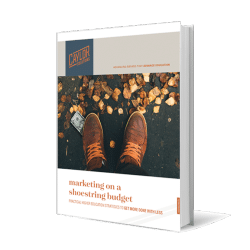Crisis Communication in Higher Ed: Pepperdine’s Wildfire Response
See how Pepperdine University redefined crisis communication in higher ed by prioritizing safety, faith, and storytelling during the California wildfires.
Blog
It’s year-end fundraising season! A time when higher education marketers and development officers work hand in hand to inspire donors and alumni to give generously. As you work on your fundraising appeal letter, refer to this helpful checklist to make sure your letter hits the mark.
There are lots of problems in the world. The good work your private college or university does every day contributes to the solution of many of these problems.
But with a mission as vast as higher education, it can be hard for donors to grasp the concrete problem they’re being asked to help solve.
So you must make sure that your fundraising appeals clearly define a problem your donors can actually solve by responding to the letter.
Consider these two examples:
Your fundraising appeal needs a clearly definable problem that your donor can help solve by giving.
The first point on the checklist is to have a clear problem—now you need a clear solution.
What do you want the donor to do? Pray? Join the alumni association? Give $25, $50, or $100 to the annual fund?
Clarify your call to action and state it at least once on the first page. You don’t want your reader to have to try and figure out what to do, and you want them to see it clearly from page 1.
Fundraising appeals with a clearly defined, attainable goal perform better than those with ambiguous, indefinite goals.
In other words, how much will it cost to solve the problem, and is it close enough to what’s reasonable for your donor?
Show your annual gift donors (those who usually give once a year at $50 to $500 per gift) how much money needs to be raised to make the problem go away in terms that makes their gift significant.
Here’s an example: Instead of simply stating the $1 million budget, show them how a gift of $100 can help close the tuition gap for a student who’s behind on her payments.
As a marketer, you know that students enroll in your school because something about what you stand for and create resonates with their core values and desires. Choosing a college or university is at first an emotional decision, and then a rational choice.
Same is true for fundraising. A number of emotional needs and motives cause people to give:
“Your gift to help fund the Bryan Sommers Sports Program ensures that more students like Bryan get the hand up they need to succeed.”
“Your prayerful support of the Rogers Nursing Center keeps the spirit of excellence alive in the hearts of nursing students… especially those like Sarah, a single mom in our night school.”
All of us are procrastinators at heart. We need a healthy dose of urgency to carry out any decision.
“If it weren’t for the last minute, nothing would get done.” – Rita Mae Brown
That’s why your appeal letter needs to convey clearly why your donor should give right now instead of later.
The urgency of the need must be clear and compelling. Don’t beat around the bush on this one.
Unlike marketing or sales copy, appeal letters are written directly to someone, as if to a friend or family member. Because of this, they must be personal.

Your appeal letter should make good use of the word “you” whenever possible. Your letter must be all about the donor, their accomplishments, their desires, and their concerns.
Use pronouns like “I” and “we” with caution.
In fact, I recommend using first person pronouns only as a way to show the connection between the author of the letter, the cause, and the donor. Some examples:
“I’m writing you today because I know you’ve been there for our new students time and time again…”
“As a fellow alumnus, I’m asking you to give as generously as you can…”
Also, make sure the letter addresses the donor correctly. It should be friendly and familiar, nothing like “Dear Dr. Charles (Chuck) Schumacher III…”
Successful appeal letters make the donor the hero of the story. Essentially, the letter shows a problem that only the donor can help solve. It’s an invitation to be the hero.
So instead of citing all the great exploits of your college or university, tell your donor how their giving made those accomplishments possible.
Instead of telling the donor how great your team is, show them how great they are by giving to make great things happen.
Personal letters, unlike essays and other academic writing, sound like the author talks in normal, everyday language.
Even if your average donor is a Ph.D., your letter should have all the warmth and ease of reading as if you were writing to your grandmother.
State your problem clearly and succinctly. Avoid jargon and professional terms that confuse people. Don’t be afraid to break a few grammar rules—and never use semicolons!
Keep paragraphs short—one or two lines each, three max.
Use adverbs and adjectives only when you need to. Rely on the strength of descriptive verbs to tell your story and motivate your reader to action.
Our brains are hard-wired for stories, not statistics or data points. Stories incite emotions within us as we read about the problem – and inspire us to action when we read about the solution.
Share a story about the challenges facing a real student. Or, feature a testimonial of how your donors have saved the day for a student.
This means that your appeal letter is easy on the eyes. I recommend using a 14 serif font, unless you’ve tested another font that works better for your donors.
Indent each paragraph. Use emphasis, underlining, and subheaders to highlight key points in the letter.
You don’t want to overdo these emphasis techniques, but your letter should have enough of them for donors to read quickly over your letter and understand exactly what you’re saying.
At the end of the day, letters in mailboxes raise more money than perfectly crafted letters that were never sent.
Do your best to plan appeals with enough time in advance to revise them, secure approval, get them to the printer, and land in people’s mailboxes on time.
Marketing and Development are two teams that must work together for the good of your organization. This checklist should be helpful as you work with your development team on this year’s annual appeal letter.
For more guidance from our team of marketing and development professionals, feel free to reach out to us here! The call is free and there’s no obligation.
Set yourself free from your shrinking marketing budget with my popular ebook Marketing on a Shoestring Budget! This ebook is jammed with practical ways to produce high-quality marketing on the cheap.
Inside, I’ll show you proven marketing tactics like…
No hype. No pie in the sky. Just real solutions for getting the job done with the budget you’ve got.
Featured Image by Monkey Business via Adobe Stock
Writing Image by Rawpixel.com via Adobe Stock
Subscribe to The Higher Ed Marketer podcast today!